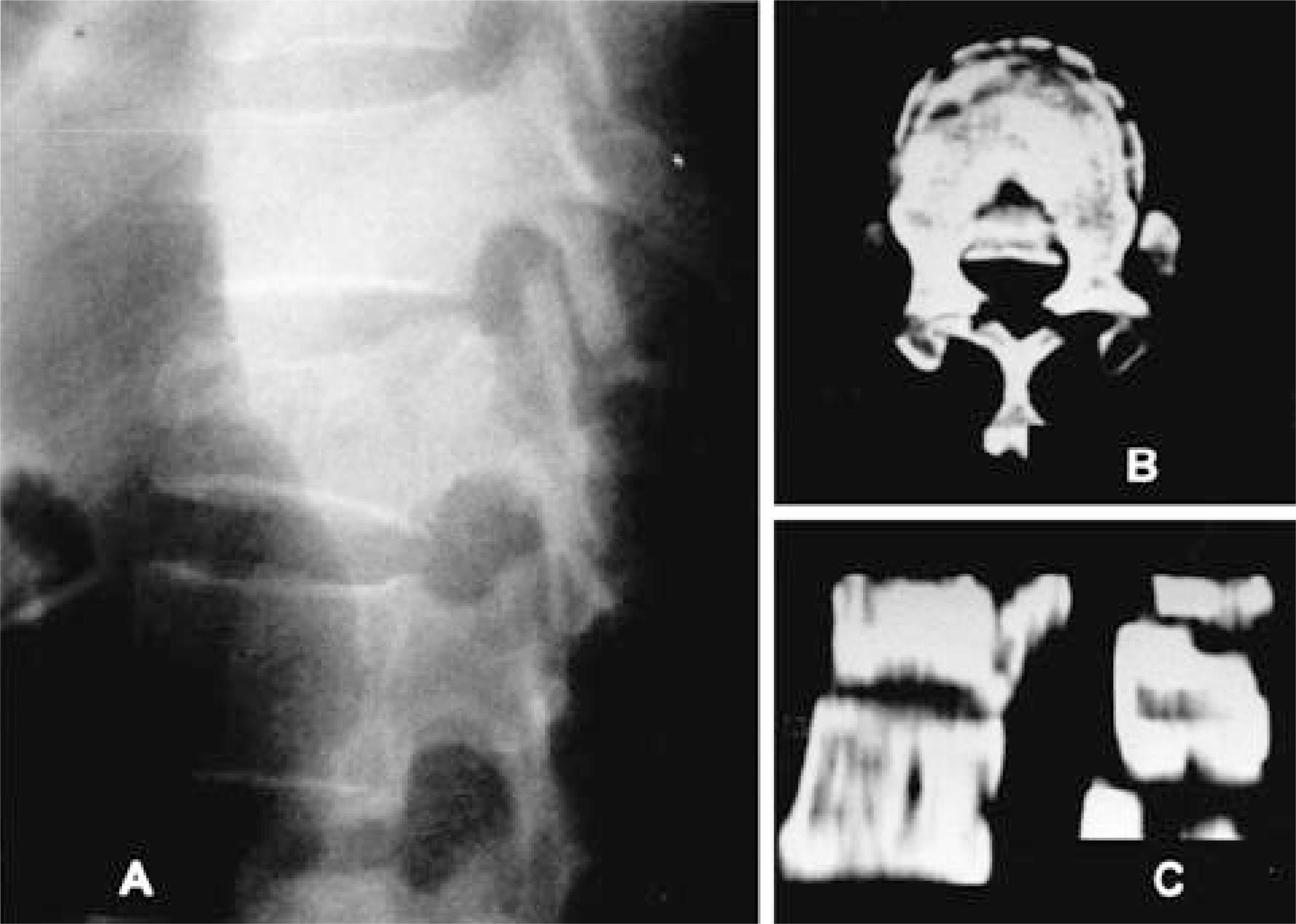Abstract
Study Design
The authors designed the retrospective study with the Load-Sharing Classification in 47 cases of the bursting thoraciclumbar fractures, which were operated using the pedicle screws.
Objective
To judge the effectiveness of posterior short segment instrumented fusion in thoraciclumbar fractures according to the Load-Sharing classification.
Material and Method
From 1995 through 1998, 47 patients who had been operated with short segment transpedicular instrumentation including fractured vertebra were selected and they were divided two groups, one below 6 point of Load-Sharing score, the other above 7 point. In follow up of average 39 months, the guide of reduction loss, which include the change of anterior vertebral body height and sagittal index were analysed statistically with the Student T- test at the postoperative time and the last followup time.
Results
In group below 6 point, the average of anterior vertebral body height was 56.2% before the operation and reduced 77.6% after the operation and measured 76.4% at final followup. The reduction loss was 1.2%. The sagittal index of preoperative 19.4。 became 10.6。 after the operation and measured 11.8° at the last followup. The loss of correction angle was 1.2。. In the other group above 7 point, anterior vertebral body height was average 51.7% before the operation and reduced 75% after the operation and measured 71.2% in last follow up, so reduction loss was 3.8%. Sagittal index was average 21.6。before the operation and corrected 12.6 after the operation and measured 14.6。 in last follow up. All of 19 patients with neurologic deficits improved by over the one Frankel grade except grade A.
Go to : 
REFERENCES
1). Bernhardt M, Bridwell KH. Segmental analysis of the sagittal plane alignment of the normal thoracic and lumbar spines and thoracolumbar junction, spine. 14:717. 1989.
2). Carl AL, Tromanhauser SG, Roger DJ. Pedicle screw instrumentation for thoracolumbar burst fractures and fracture-dislocation. Spine. 17:S317–S324. 1992.
3). Chung JY, Rhym IS. Short segment transpedicular Cotrel-Dubousset instrumentation including involved vertebra for fractures of thoracic and lumbar spine. J Korean Orthop Assoc. 29(3):940–948. 1994.

4). Frankel HL, Hancock DO, Hyslop G, Melzak J, Michae-lis LS, Ungar GH, Vernon JDS, Walsh JJ. The Value of Postural Reduction in the Initial Management of Closed Injuries of the Spine with Paraplegia and Tetraplegia Pant I. Paraplegia. 7:179–192. 1969.
5). Gurr KR, McAfee PC. Biomechanical analysis of anterior and posterior instrumentation systems after cor -pectomy: A calf-spine model. J Bone Joint Surg. 70A:1182–1191. 1988.
6). Jeong ST, Cho SH, Song HR, Koo KH, Park HB, Chung UH. Comparison of short and long - segment fusion in thoracic and lumbar fracture. J Korean Spine Surg. 6(1):73–80. 1999.
7). Lee CS, Chung SS, Jung HW, Kim ES. Decision of posterior fixation level by load-sharing classification in thoracolumbar and lumbar bursting fracture. J Korean Spine Surg. 8(1):27–38. 2001.
8). McAfee PC, Weiland DJ, Carlow JJ. Survivorship analysis of pedicle spinal instrumentation. Spine. 16(sup -plement 8):422–427. 1991.

9). McCormack T, Karaikoric E, Gaines RW. The Load Sharing Classification of Spine Fractures, Spine. 19:1741–1744. 1994.
10). McLain RF, Sparling E, Benson DR. Early Failure of Short-Segment Pedicle Instrumentation for Thoracolumbar Fractures. J Bone Joint Surg. 75-A:162–167. 1993.
11). McNamara MJ, Stephens GC, Spengler DM. Tr ans-pedicular Short Segment Fusion for Treatment of Lumbar Burst Fractures. J Spinal Disord. 5:183–187. 1992.
12). Parker JW, Lone JR, Karaikoric EE, Gaines RW. Successful Short-Segment Instrumentation and Fusion for Thoracolumber Spine Fractures. Spine. 25:1157–1169. 2000.
Go to : 
Figures and Tables%
 | Fig. 1.Mild bursting fracture with 55% anterior height reserve rate and 7˚ sagittal index (5 point, Group I). Fig. 1. A. correction of 4˚~9˚ for restoration of normal alignment on lateral film (2 point). Fig. 1. B. only mild (< 2 mm) fragment displacement over less than 50% of the body on axial plane section CT (2 point). Fig. 1. C. fracture involve only the top third of the body (1 point). |
 | Fig. 2.(Group I : same patient with Fig. 1). Fig. 2. A. The fracture is handled successfully with short segment transpedicular instrumentation including fractured vertebra (anterior height reserve rate : 74%, sagittal index : 5˚). Fig. 2. B. Followup film at 41 months showing one screw - was inserted to most upper vertebra - broken but, our guide of reduction loss and result were acceptable (anterior height reserve rate : 72%, sagittal index : 5˚). |
 | Fig. 3.Severe bursting fracture with 30% anterior height reserve rate and 30˚ sagittal index (9 point, Group II). Fig. 3. A. correction of >10˚ for restoration of normal alignment on lateral film (3 point). Fig. 3. B. more than 2 mm fragment displacement beyond 50% of the body on axial plane section CT (3 point). C. fracture involve entire body (3 point). |
 | Fig. 4.(Group II : same patient with Fig. 3). Fig. 4. A. The fracture is handled successfully with short segment transpedicular instrumentation including fractured vertebra (anterior height reserve rate : 71%, sagittal index : 19˚). Fig. 4. B. Followup film at 37 months showing acceptable guide of reduction loss (anterior height reserve rate : 70%, sagittal index : 20˚). |




 PDF
PDF ePub
ePub Citation
Citation Print
Print


 XML Download
XML Download